|
Series:
Prominent
Zarathushtis
Author:
Dr.
Khosro Mehrfar
Subtopics:
Reference:
Related
Articles:
Related
Links:
|
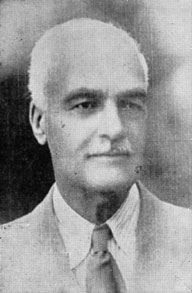
"Given that on this vast planet, every nation is pursuing
her own course and at the same time trying to recognize and appreciate her
children who have contributed to her success, I as a regular lay-person would
like to talk about one of the greatest men ever to walk on this earth.
Although I feel I am too small to talk about him, nevertheless it is my
wish and my hope to share my tribute to him with you.
My comments are about Ferdowsi and his services to this land - a land
that had almost lost its name, language, culture and even identity.
This great man of our history, with his immense and powerful conviction,
almost single handedly resurrected the old glory of Iran and helped save her
true identity. And although he did
not receive any material reward in return, he left his name as an ever-fresh,
everlasting icon of our Persian history.
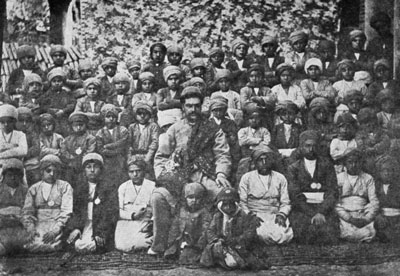 |
|
Keikhosrow Shahrokh as a
young school teacher with his students
in Zarathushti school in Kerman. |
It
has been a while since some distinguished Iranians, including Mr.
Moshir-ol-dolleh, Mostofi-ol-mamalek, Zaka-ol-molk, Alaie and Taghizadeh,
decided to recognize and appreciate the contributions of our ancestors to this
land. Thus, the society for the
preservation and protection of national treasures, which has always paid special
attention to the revival of our identity, has decided to build a dignified
mausoleum that is in keeping with the stature and prestige of such a national
and beloved figure. As we all know,
at this time, except for a handful of dust, there is nothing else covering the
grave of this great man to whom we all owe our very identity…”
It was with these simple and yet effective words,
that Arbab Keikhosrow Shahrokh, as he was known in the elite Iranian society of
early 20th century, started a personal crusade to commission the planning,
design and construction of a mausoleum for Ferdowsi at his burial site in the
city of Tus, Iran, which was also his birthplace. This speech, given by the
great Iranian patriot Arbab Keikhosrow Shahrokh, at the 121st meeting of the 6th
Iranian congress on Tuesday 30th of Khordad 1296 Yazdgerdi, became a national
milestone.
For Keikhosrow Shahrokh, the love of Iran ran
deep to the core of his existence. One of its manifestations was his resistance to the notorious
1919 concession imposed on the Iranian nation by the imperialistic forces of the
British and Bolshevik governments. Contributing to this concession was the lack
of leadership, ownership and accountability in the higher echelons of the
Iranian government. This deal would
have given those two powers exclusive rights over the development of some of the
most precious natural resources of the nation.
|
|
|
Keikhosrow Shahrokh
as a young deputy of Parliament.
Source: "The Strangeling of Persia"
by William Schuster |
At
the time, Keikhosrow Shahrokh was in the U.S. and it is believed that he was the
very first person to mobilize a popular uprising against the 1919 concession.
At first he made several speeches in the US congress and asked for help
from that body. His appearances at
the US capitol were arranged with the help of his acquaintance, Mr. Morgan
Shushter, an American financial consultant, who had been employed by the Iranian
parliament years earlier in an effort to put Iran’s financial house in order.
Once Shahrokh had secured the support of the US
congress, he interrupted his stay in the US and went back to Iran, where he
helped to mobilize a popular uprising against the imposed concession.
This carefully planned effort started when Shahrokh invited the MPs of
Iran to his home in Naderi Street. Eventually Shahrokh coordinated the whole
process. The tremendous effort paid
off when, by the power of the people of Iran, the notorious 1919 contract was
cancelled. The original document
cancelling the contract, which was kept in the office of the archives during the
past regime, was created and crafted by Keikhosrow Shahrokh and is in his own
handwriting.
In 1289 YZ, when, due to a hidden agenda and a
vast effort, the national imperial jewels of Iran were being exported illegally
outside of Iran, it was Keikhosrow Shahrokh who uncovered the treacherous plot
and with bold and brave moves, presented it to the Iranian parliament. These
courageous actions of Keikhosrow Shahrokh, cancelling the contract and saving
the crown jewels, will remain in our history forever, an example for generations
to come.
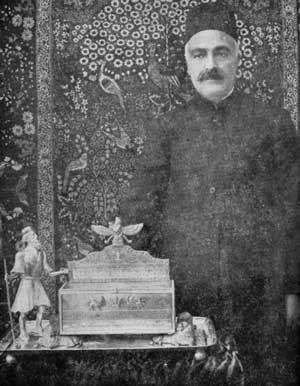
|
|
Keikhosrow Shahrokh
presenting Zarathushiansgifts
at Reza shah's coronation. |
Iranians in general, and Zoroastrian Iranians in
particular, owe a lot more to Keikhosrow Shahrokh.
This article attempts to shed some light on a few of his achievements in
his fruitful and very active life of 63 years.
Keikhosrow Shahrokh was born into one of the very
well known families of Kerman in 1243 Yazdgerdi (YZ).
His great grandfather was the astrologer of the king of Iran at the time
and his grand father continued in the tradition of the family and extended his
services to the public. His father, Shahrokh was assigned as a teacher to an
elementary school in Kerman by the late Manekjee Limjee Hataria.
Keikhosrow Shahrokh lost his father when he was 6
months old. And so it was his iron
willed mother who planted the seed of “Love for Iran” in his mind from a very early age and
made him what he came to be, a strong and powerful man of conviction, helping
many others to halt the downward course of Iranian social, economical and
cultural life.
Keikhosrow Shahrokh started his elementary
education in the same school where his late father used to teach.
At the age of 9, the family moved to Tehran and he continued his
education for another 3 years. It
was on the advice and sponsorship of Manekjee Limjee Hataria, that at the age of
12, Keikhosrow Shahrokh and his younger brother were sent to Bombay, India and
started a new life under Sir Dinshah Manekjee Petit of the Akaber Society of the
Parsees of India.
In Bombay, Keikhosrow Shahrokh pursued higher
education and after graduation moved back to Kerman, Iran where he was assigned
as a schoolteacher. His yearly
salary was fixed at 90 tomans, which was a modest salary at that time.
However, the Zoroastrians of Kerman, knowing full well the contributions
and the long history of service that his ancestors had made to them, collected
money among themselves and increased Shahrokh’s salary to 300 tomans a year to
provide him with a better living.
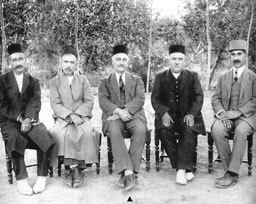 Keikhosrow Shahrokh’s first assignment as the
teacher of that tiny school was the start of a life full of service and
contributions to his community and nation.
Here, I quote a statement published in one of the periodicals of that
time, “Andisheh MA” or “Our Thoughts” about Keikhosrow Shahrokh. Keikhosrow Shahrokh’s first assignment as the
teacher of that tiny school was the start of a life full of service and
contributions to his community and nation.
Here, I quote a statement published in one of the periodicals of that
time, “Andisheh MA” or “Our Thoughts” about Keikhosrow Shahrokh.
“His years in Bombay and the study that he made
about the Parsees of India had a profound impact on Keikhosrow Shahrokh’s mind
and soul. Those years opened his
eyes and heart to the glories of the past, and the dignity and pride of a humane
nation. Perhaps it was the awakening of those deep feelings that began the
inspiration and pattern of a life which was selflessly dedicated to the progress
and success of his beloved country of Iran.”
One of the first things that Keikhosrow Shahrokh
did, upon his return to Iran, was to change the way he dressed.
This was part of a greater attempt to educate the laymen of his country
about the progress of the world around them. It was also an attempt to decrease
the amount of bigotry and prejudice that had saturated the society, paralyzing
every aspect of Iranian life. This bigotry and prejudice was one of the main
reasons for the spiral downfall of a great nation with a rich heritage and
culture.
His attempts to change the society and elevate it
into a better state of life started with a series of reforms that he made to his
school. He started to move it from
the old outdated “Maktab Khaneh” to a schooling system with better services
and more qualified teachers who knew more than just reading old manuscripts.
He then started to collect money to fund a Zoroastrian high school in
Kerman. Parallel to this effort, he
had initiated the building of the very first Zoroastrian girls’ elementary
school, working with the investment of the late Jamshid Jahangir.
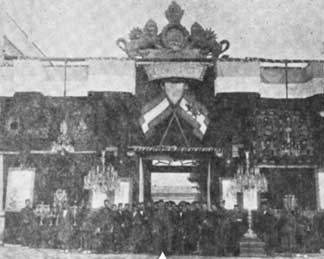 |
|
Keikhosrow Shahrokh standing with members
of parliament
awaiting Reza shah's arrival. |
After his success in these early stages, his
focus was turned back to what I described above as “Changing the Way.”
He noticed that all Zoroastrians had to wear different clothing than
their Muslim neighbors, even though the two groups had lived together for
hundreds of years. The special garb
was intended to distinguish Zoroastrians from Muslims and therefore was a symbol
of prejudice. Although there were
some Muslims who lived in peace and friendship with their Zoroastrian countrymen
and women, the majority of them, due to lack of knowledge and intentional
misinformation, treated the Zoroastrians very poorly. It was ironic that in a land which logically and historically
belonged to them, Zoroastrians were not considered regular citizens. They were
often hurt, prosecuted and many times even murdered because of their ancestral
belief.
Keikhosrow Shahrokh started the sequence of
liberating events by mandating that all the students of the Zoroastrian
educational institutions, which numbered 2 or 3 schools in Kerman, should wear
the same clothes as anyone else in the country. Though this seems like a small
step to us, it violated a major taboo of the time. And it required a man of the
stature of Keikhosrow Shahrokh to initiate this policy. During all his time in
Kerman, he was in constant battle with unjust governors, mayors and local
bigots. After a few years of brave service, when he recognized that his efforts
had paid off and things were changing for the better in Kerman, he decided to go
to Russia to broaden his scope of knowledge.
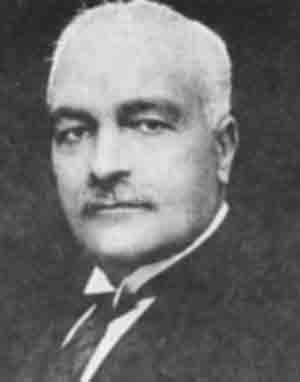 He stayed in Russia about 18 months, after which
he left for Tehran and gained employment as one of the managers in the vast
financial empires of the late Arbab Jamshid Jamshidian. This man was a
well-respected, powerful investment giant of Iran, who practically had the full
financial heart of Iran in his hand with his networks of banks all across the
country. In fact, Jamshidian ran the first and only banking institutions of the
country. Unfortunately, the foreign powers of the time, the British and the
Russians, finally executed a plot to topple this man’s banking system by each
creating their own banks. It was against their imperialistic interests for the
banking system in Iran to be run by a native Iranian. He stayed in Russia about 18 months, after which
he left for Tehran and gained employment as one of the managers in the vast
financial empires of the late Arbab Jamshid Jamshidian. This man was a
well-respected, powerful investment giant of Iran, who practically had the full
financial heart of Iran in his hand with his networks of banks all across the
country. In fact, Jamshidian ran the first and only banking institutions of the
country. Unfortunately, the foreign powers of the time, the British and the
Russians, finally executed a plot to topple this man’s banking system by each
creating their own banks. It was against their imperialistic interests for the
banking system in Iran to be run by a native Iranian.
While working as a manager in one of
Jamshidian’s banking institutions, with the encouragement and support of the
late Foroghi, Shahrokh started to write a book, which was later titled “The
Reflection of the Mazdayasnian Religion.”
Jamshidian provided the financial support for publishing the book, which
for its time was unique in style and presentation.
During the same years, the Iranian nation was
awakened to the promise of freedom and the yearning for democracy, manifesting
itself in the “Constitution of the Mashrootiat.”
Keikhosrow Shahrokh, along with many other elite persons and
intellectuals of his time, joined the movement which, although short-lived,
finally after many sacrifices resulted in the very first democratic
establishment of Iran after more than 1200 years.
It was due to the sacrifice of Keikhosrow Shahrokh and others like him
that the people of Iran tasted the brief sweetness of democracy in their
country.
Keikhosrow Shahrokh became a member of the
Iranian parliament in the 2nd period of its existence with full consent of the
people, and continued to be re-elected by the people until the 12th period.
I would like to mention that the late Mehraban Mehr, the distinguished
father of the professor emeritus Farhang Mehr of Boston University, who was
himself head of the “Shiraz” university before emigrating to America, was
instrumental in most of the achievements that Keikhosrow Shahrokh accomplished
during his lifelong career of selfless dedication to the Iranian community. This
was especially apparent during the long years of Keikhosrow Shahrokh’s service
in the Iranian parliament. The late Mehraban Mehr was the treasurer of the
Parliament for about 45 years. This was a critical and sensitive position that
no one except Mehr, a man everybody trusted and respected, could have managed so
truthfully and honestly.
There have been many achievements that either
came about through the direct involvement of Keikhosrow Shahrokh or under his
vision and leadership. I have saved the telling of one of his major
accomplishments for the end of this account, an achievement of unbelievable
magnitude and far-reaching impact. And
that was the change that he brought to the Iranian calendar.
This was truly one of the greatest achievements
of this man of power and conviction. Prior to Shahrokh’s reform, the Iranian
calendar was one of Arabic origin starting with the migration of Prophet
Mohammad and known as “Hejri Ghamarei.” Keikhosrow Shahrokh, with his
intense belief in Iranian culture and Persian identity, along with a group of
Iranian intellectuals, initiated a motion in the congress to change the
calendar. It was a daring and unusual move for anybody to challenge the
thousand-year-old calendar system of the country. Those bold actions made
Keikhosrow Shahrokh one of the shining examples of Iran’s recent history.
|
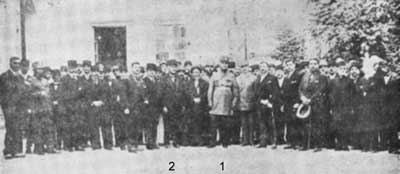
|
|
Reza Shah Pahlavi (1) standing with
several prominent figures
including Keikhosrow Shahrokh (2). |
Keikhosrow Shahrokh passed away at the age of 65
in Tehran after a productive and fruitful life of selfless dedication and
conviction. May his beloved soul
rest in comfort and peace in the abode of the Supreme Intellect, Ahura Mazda.
|